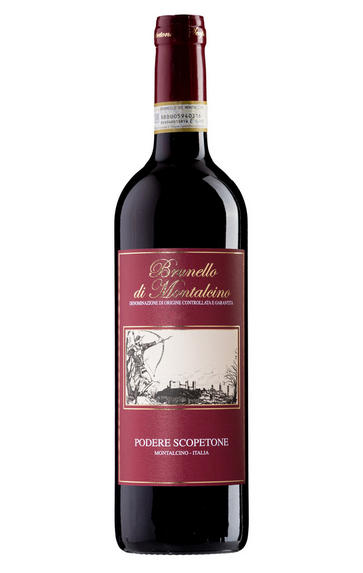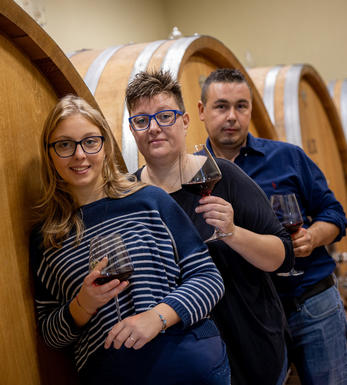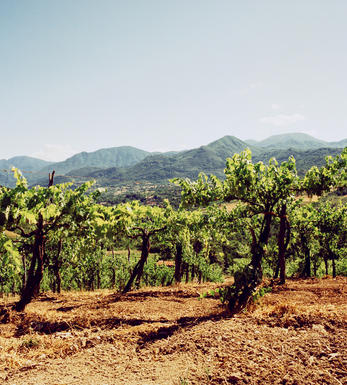
2018 Brunello di Montalcino, Scopetone, Tuscany, Italy

Critics reviews
The 2018 Brunello di Montalcino is dark and woodsy in the glass, with wild herbal tones, crushed rocks and plums forming its bouquet. This is round in feel, showing its minerality up front, as brisk acidity helps to enliven the tart wild berry fruits within. The 2018 finishes with medium length and savoury, leaving edgy tannins to tug at the cheeks.
Eric Guido, Vinous.com (October 2022)
Mid to deep ruby with bricky rim. Iron, Amarena cherry and hints of gingerbread. Exotic cassis and cherry palate that is clearly very ripe. Very unusual, and hard to see right now how this will develop further.
Walter Speller, Jancisrobinson.com (November 2022)
Walter Speller, Jancisrobinson.com, November 2022
At lofty elevations near the town of Montalcino, Scopetone totals five hectares. From the now 40-year-old vines, owners Loredana Tanganelli and Antonio Brandi carve out 7,000 bottles of Brunello annually. With forest underbrush, walnut and wet earth, this 2018 makes way for more lifted tones of pressed cherry blossom. Midweight and lightly structured, it flows effortlessly though is still tight through the core. Not an obvious wine, but it has length and balance.
Michaela Morris, Decanter.com (November 2022)
About this WINE

Scopetone, Tuscany
This is one of Montalcino’s hidden treasures. Unknown to many, Ferruccio Biondi – credited with “inventing” Brunello – planted his first Sangiovese on the best location he could find in the region. That was not the now-famous Tenuta Greppo estate, however, but rather the Scarnacuoia cru – where we find Podere Scopetone’s vines today.
This tiny, hallowed site, replanted in 1978, gives a taste of the region’s origins. Its soils are some of the area’s oldest due to the exfoliating exposure of this treacherously steep slope. Since local couple Loredana Tanganelli and Antonio Brandi acquired it in 2009, they have given new life and new meaning to Brunello’s original vineyard. They’re building a reputation for making some of the region’s purest, most desirable wines. Their total production is a tiny 2.5 hectares. They farm organically, though you won’t find certification on the label.

Brunello di Montalcino
Along with Chianti, Brunello di Montalcino is Tuscany's most famous DOCG and the region's boldest expression of Sangiovese. Located 30 miles south of Siena with the hilltop town of Montalcino as its epicentre, its 2,000 hectares of vines are naturally delimited by the Orcia, Asso and Ombrone valleys. Brunello is the local name for the Sangiovese Grosso clone from which Brunello di Montalcino should be made in purezza (ie 100 percent).
The Brunello di Montalcino DOCG has a whale-like shape: at its head, at 661 metres above sea level on ancient, stony galestro soils facing east and southeast lies the town of Montalcino, where the DOC was founded. As you follow the spine south towards the tail, the vineyards lose altitude – those around Colle Sant'Angelo are at 250 metres – while the soils become richer with iron and clay. Further east, in the shadow of the 1,734 metre Mont'Amiata lies the village of Castelnuovo dell'Abate where the vineyards are strewn with a rich mix of galestro, granitic, volcanic, clay and schist soil types.
Historically, the zone is one of Tuscany's youngest. First praised in 1550 by Leandro Alberti for the quality of its wines, it was Tenuta Il Greppo who bottled the inaugural Brunello di Montalcino in 1888. By 1929, the region had 925 hectares of vines and 1,243 hectares of mixed crops, while in 1932 it was decreed that only those wines made and bottled within the commune could be labelled as Brunello di Montalcino. Since then, the number of producers has risen from 11 in 1960 to 230 in 2006, while over the same period the vineyards have expanded from 1,000 hectares to 12,000. The region earned its DOC in 1966, and was upgraded to DOCG in 1980.
Brunello di Montalcino cannot be released for sale until five years after the harvest, or six years in the case of Brunello di Montalcino Riserva. During this time the wines should be aged for at least two years in oak, followed by at least four months in bottle (six months for Riservas); maximum yields are 55 hl/ha.
Rosso di Montalcino is declassified Brunello di Montalcino, released for sale 18 months after the harvest.
Recommended producers: Costanti, Fuligni, Lisini, San Giuseppe, Soldera, Cerbaiona

Sangiovese
A black grape widely grown in Central Italy and the main component of Chianti and Vino Nobile di Montepulciano as well as being the sole permitted grape for the famed Brunello di Montalcino.
It is a high yielding, late ripening grape that performs best on well-drained calcareous soils on south-facing hillsides. For years it was blighted by poor clonal selection and massive overcropping - however since the 1980s the quality of Sangiovese-based wines has rocketed upwards and they are now some of the most sought after in the world.
It produces wines with pronounced tannins and acidity, though not always with great depth of colour, and its character can vary from farmyard/leather nuances through to essence of red cherries and plums. In the 1960s the advent of Super Tuscans saw bottlings of 100% Sangiovese wines, as well as the introduction of Sangiovese/Cabernet Sauvignon blends, the most famous being Tignanello.


Buying options
Add to wishlist
Description
This comes from Brunello’s original Scarnacuoia vineyards, which are some of the coolest in the region. Yields were lower in 2018, the colour lighter and alcohol lower, yet there is still focus in this wine The old vines give this Brunello an enchanting nose: cinotto, blue fruits, mineral details and smoky depth.
Three years in large 33hl oak botti, followed by 12 months in cement, allow the wine to relax and smooth. The results are bright, open and composed: peaches and glossy red berries with the bite of pomegranate. The tannins are softer and cleansing than many vintages, while the finish is extended by floral high notes and a minty mineral tang.
Drink 2023 - 2038
wine at a glance
Delivery and quality guarantee